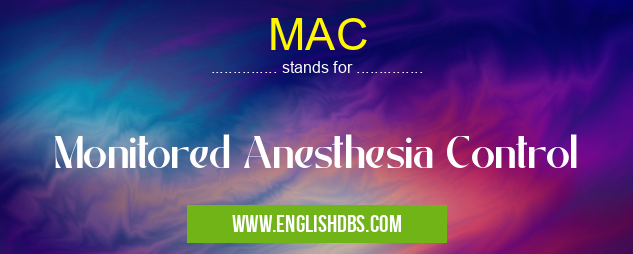What does MAC mean in HEALTHCARE
MAC, short for Monitored Anesthesia Care, refers to a technique used during surgical procedures to provide patients with both sedation and pain relief while maintaining consciousness. This technique involves the administration of medications by an anesthesiologist, who continuously monitors the patient's vital signs and level of sedation throughout the procedure.

MAC meaning in Healthcare in Medical
MAC mostly used in an acronym Healthcare in Category Medical that means Monitored Anesthesia Control
Shorthand: MAC,
Full Form: Monitored Anesthesia Control
For more information of "Monitored Anesthesia Control", see the section below.
» Medical » Healthcare
Monitored Anesthesia Care (MAC): An Introduction
Key Features of MAC
- Patient Consciousness: Unlike general anesthesia, MAC allows patients to remain conscious during the procedure.
- Pain Relief: MAC provides effective pain control through the use of sedatives and analgesics.
- Continuous Monitoring: The anesthesiologist closely monitors the patient's vital signs and level of sedation, ensuring their safety and well-being.
- Minimal Risks: MAC carries fewer risks compared to general anesthesia, as patients are able to breathe on their own and maintain their reflexes.
Advantages of MAC
- Reduced Post-Operative Nausea and Vomiting: MAC has been shown to reduce the incidence of post-operative nausea and vomiting.
- Faster Recovery: Patients under MAC typically recover more quickly than those under general anesthesia.
- Cost-Effectiveness: MAC can be a cost-effective alternative to general anesthesia for certain procedures.
Conclusion
Monitored Anesthesia Care (MAC) is a safe and effective technique that provides patients with pain relief and sedation while maintaining consciousness during surgical procedures. Its key features include continuous monitoring, minimal risks, and advantages such as reduced post-operative nausea and vomiting, faster recovery, and cost-effectiveness.
Essential Questions and Answers on Monitored Anesthesia Control in "MEDICAL»HEALTHCARE"
What is MAC (Monitored Anesthesia Control)?
MAC is a type of anesthesia that involves a combination of sedatives and pain relievers administered intravenously to provide a controlled level of sedation and pain relief while maintaining consciousness.
Why is MAC used?
MAC is often used for procedures that require sedation but not general anesthesia, such as endoscopies, colonoscopies, and dental work. It can also be used as a supplement to general anesthesia to reduce the amount of inhaled anesthetic required.
How is MAC administered?
MAC is administered intravenously by an anesthesiologist or nurse anesthetist. The patient is typically awake during the procedure and can respond to verbal commands. The level of sedation can be adjusted as needed to ensure the patient's comfort and safety.
What are the benefits of MAC?
Benefits of MAC include:
- Lower risk of complications compared to general anesthesia
- Shorter recovery time
- Provides both sedation and pain relief
- Preserves respiratory function
What are the risks of MAC?
Risks associated with MAC are rare but may include:
- Oversedation or undersedation
- Respiratory depression
- Allergic reactions
- Nausea and vomiting
Who should not receive MAC?
MAC may not be suitable for patients with:
- Unstable vital signs
- Severe respiratory or cardiovascular conditions
- Uncontrolled pain
- Mental health disorders
MAC also stands for: |
|
| All stands for MAC |
